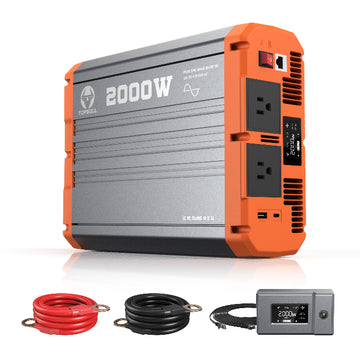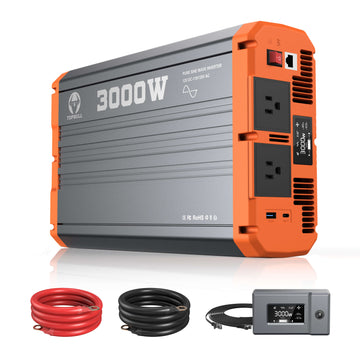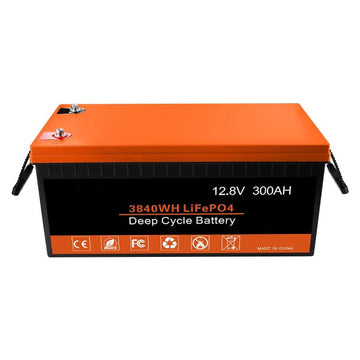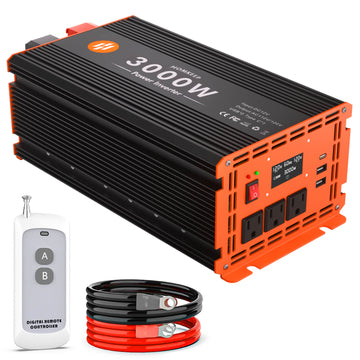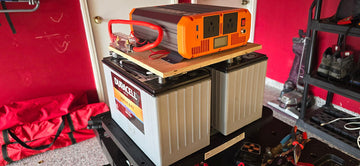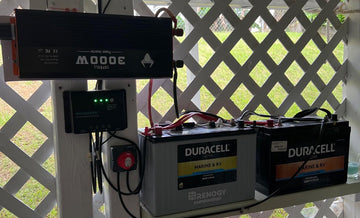Imagine this: you're parked at a campsite in your RV, getting ready to heat a quick meal after a long day of hiking. Or maybe there's a power outage at home, and you rely on a backup system to keep your essentials running. In these moments, a microwave isn't just a convenience, but a necessity.
But running a microwave off the grid isn't as simple as plugging it into any power source. Microwaves are high-power appliances that draw significant continuous wattage and generate large surge loads when starting up. That's why a reliable pure sine power inverter for your microwave is essential.
This guide will walk you through everything you need to know, including how many watts does a microwave oven use, whether you can run a microwave on an inverter, what size inverter for microwaves you need, and how to find the best microwave inverter for your RV or off-grid lifestyle. Scroll down and get started!
Related Reading:
How Much Does a Power Inverter Cost: Smart Buying Tips
How to Install a Power Inverter in an RV [Step by Step]
Understanding Microwave Power Requirements
Before choosing the best microwave inverter for your RV or off-grid setup, it's crucial to understand how much power your microwave uses, and why that matters when selecting an inverter. Microwaves are deceptively simple appliances but have complex power needs, especially at startup.
Typical Microwave Wattage
Most microwave ovens consume between 600 to 1200 watts during regular operation. However, the wattage listed on the label usually refers to cooking power, not the total electrical power the microwave draws from your power supply. In practice, the actual power consumption is often 30–50% higher than the advertised wattage.
Quick example:
- A 700W microwave may draw around 1100W
- A 1000W microwave could draw 1500W or more
Surge Power and Why It Matters
Microwaves have a high initial power surge when they start up. This surge, also called peak power or starting wattage, can be 1.5 to 2 times the rated power. So, a 1000W microwave might spike to 1800W–2000W momentarily when turned on.
This surge only lasts a few seconds, but your inverter must be capable of handling it. If the inverter's surge capacity is too low, the microwave may fail to start or trip the inverter's safety system.
Quick example:
- A 1200W microwave may need an inverter with at least 2000–2400W surge capacity
- A 700W compact unit could still require 1200–1500W surge support
What About Small or RV Microwaves?
Smaller microwaves, often used in RVs or compact kitchens, tend to have lower cooking power, typically 500–800W. These are better suited for off-grid applications, but you still need to factor in their surge demands.
In RV or van life forums, many users report that even a “700W microwave” won't run reliably on a 1000W inverter unless the surge capacity is high and the inverter provides pure sine wave output.
Why Pure Sine Wave Inverters Are Essential for Microwaves
Now that you know how much power your microwave uses, the next key question is: What kind of inverter should you use? Not all inverters are created equal, especially when it comes to powering high-demand appliances like microwaves.
Clean Power Output
Microwaves are more than just heating boxes, as they contain complex electronic components that control timing, power levels, and safety functions. These systems require clean, stable electricity to work properly. That's why pure sine wave inverters are the best choice. They replicate the smooth, continuous flow of utility power, making them compatible with virtually all household appliances.
Avoiding Damage from Modified Wave Inverters
Many budget inverters use modified or square sine wave technology to reduce costs. While these may work for basic devices, they can be harmful to microwaves, leading to:
- Unusual buzzing or humming sounds
- Incomplete or uneven cooking
- Overheating of the appliance's internal circuitry
- Reduced lifespan or even permanent damage
Several off-grid users have reported that their microwaves either perform poorly or fail when connected to modified sine wave inverters.
Efficiency and Longevity
With a pure sine wave inverter, your microwave operates at its designed efficiency level. This means:
- Faster cooking times
- Lower energy waste
- Reduced wear and tear on internal components
If you're investing in a microwave for your RV, van, or emergency backup system, pairing it with a high-quality pure sine wave inverter is essential for long-term reliability.
Selecting the Right Inverter Size for Your Microwave
Choosing the best microwave inverter doesn't stop at waveform. You also need to select the correct size for inverters to meet your microwave's power demands, including its surge requirement.
Calculating Power Needs
Start by checking your microwave's rated power, then multiply that by 1.5 to 2 to estimate the surge power requirement. For example:
- A 1000W microwave may require up to 2000W of inverter capacity during startup.
- A 700W microwave may surge to 1300–1400W at launch.
If you plan to run other devices alongside the microwave, factor in their wattage as well.
Add a Safety Margin
To ensure safe and consistent operation, choose an inverter rated 20–30% above your microwave's surge power. This extra buffer:
- Helps prevent overload trips
- Increases inverter efficiency
- Extends the lifespan of both your microwave and inverter
For instance, a 1000W microwave might work best with a 3000W pure sine wave inverter, providing both surge protection and headroom for other appliances.
Consider Your Application
Whether you're:
- Living in a motorhome or van
- Going off-grid camping
- Preparing for a power outage at home
Your inverter choice should match your lifestyle. In RVs, space and power limits are key. For home backup, a larger inverter may be justified to run multiple appliances simultaneously. And for solar setups, efficiency becomes even more critical.
Topbull Pure Sine Inverters: Optimal Picks for Microwave
When it comes to powering a microwave off-grid, not just any inverter will do. You need one that delivers clean energy, handles surge demands, and ensures the safety of both your appliances and your power system. That's where Topbull's pure sine wave inverters come in, as they are designed specifically for high-power devices like microwaves, with the reliability and performance to match.
Why is Topbull the best microwave inverter solution?
-
Pure Sine Wave Output: Unlike modified sine wave inverters, Topbull delivers clean, consistent power, just like grid electricity. This ensures smooth microwave operation, eliminates noise, and prevents damage to sensitive components.
-
Built-in Multi-layer Protections: Topbull inverters include smart safeguards against overload, overheating, voltage issues, and short circuits—crucial for handling microwaves' high surge demands safely.
-
Versatile Compatibility: Ideal for RVs, off-grid setups, solar systems, and emergency backup. Supports not only microwaves but also fridges, coffee makers, TVs, laptops, and more.
-
Intelligent Cooling & Digital Display: Temperature-controlled fans prevent overheating, while the LED display shows voltage, load, and battery status, keeping you fully informed.
- Wide DC Input Range & AC Output Options: Compatible with 12V systems and 110V/120V output, Topbull fits seamlessly into most mobile and home power setups.
Here are the best Topbull microwave inverter options for different needs.
| Model | Best For | Ideal Use Cases | Why Choose It |
| Topbull 2000W Pure Sine Wave Inverter | Small to medium microwaves (600W–1000W) | Compact RV kitchens, van life setups, and minimal off-grid cabins | Delivers smooth, stable power with sufficient surge capacity for standard microwaves. Lightweight and efficient—perfect for space-conscious setups. |
| Topbull 3000W Pure Sine Wave Inverter | Standard household microwaves (1000W–1200W) with a few extra appliances | Full-size RVs, remote cabins, and solar battery backup setups | Offers more power headroom to run additional devices like LED lights, mini-fridges, or laptops without overload risks. Ideal for moderate power needs. |
| Topbull 4000W Pure Sine Wave Inverter | High-powered microwaves and multiple appliances simultaneously | Emergency home backup systems, full-featured motorhomes, and larger solar installations | Built for demanding setups with high surge requirements. Supports heavy loads reliably, great for off-grid homes or all-in-one RV power systems. |
Final Thoughts
Choosing the best microwave inverter is crucial for safety and efficient off-grid use. From RV adventures to emergency home backup, a reliable inverter ensures your microwave operates without glitches or risk of damage. Topbull's pure sine wave inverters deliver clean, stable energy, built-in multi-layer protections, and versatile compatibility, making them the best microwave inverter solution for a wide range of off-grid scenarios.

